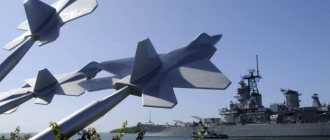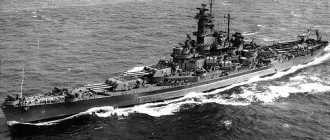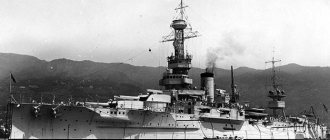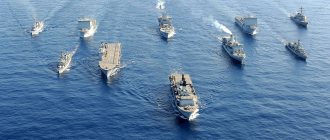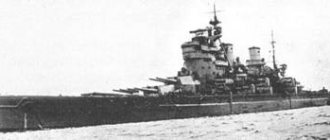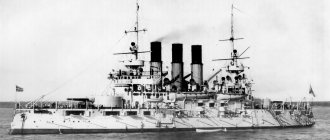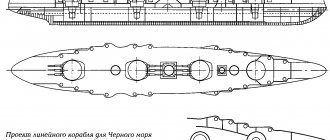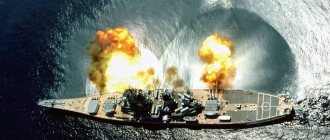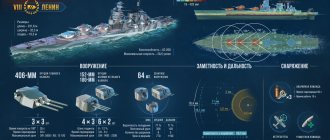Battleship, also known as a battleship. In the Age of Enlightenment, it was the most armed and dangerous ship in the sea.
Any power aspiring to dominance in the oceans had to have at least several dozen ships of this class in its squadron in order to feel confident and not fear for the position of its fleet. But in the end, progress: the development of new means in the fight against enemy floating ships, the advent of the steam engine and the popularization of armored ships instead of already obsolete wooden ones, led to the decline of the era of battleships in the mid-19th century. They were forgotten for almost half a century, until 1906. At that time, the old model battleships no longer satisfied the demands of the military authorities; they were too vulnerable when attacking ground structures, and could not oppose anything to detachments from smaller and more mobile ships.
"Gangut"
Therefore, as a response to new challenges, the British began to develop a new type of military sailor. Since this ship was supposed to become the new owner of water territories, the name was based on the already forgotten ruler of the seas and oceans - the battleship. Now the most powerful and armed floating carrier of death and destruction was called a battleship.
Peculiarities
Battleships are powerful artillery armored ships. At the beginning of the Great Patriotic War, there were a lot of them in the country's arsenal. The battleships of the USSR had high-quality weapons in the form of various guns, which were constantly modernized. Most often, the weapons consisted of large-caliber machine guns and torpedo tubes. These ships provided the defense of Leningrad, Sevastopol and other coastal cities.
Specifications
The length and width of each vessel at laying were 182 and 27 meters, respectively. The engine, powered by coal, produced a power of 42 thousand hp, which allowed the battleships to accelerate to 23 knots, with an estimated cruising range of 4000 miles.
The main armament was 12 ship guns of 305 mm caliber. The anti-mine battery consisted of 16 guns, which were loaded with 120 mm shells. Due to the inconvenience of placement, it was difficult to use them in battle in windy weather.
Sevastopol class
Battleships of this class had a monitor-shaped hull, in which the freeboard area and icebreaker-shaped stem were minimized. With a short hull length, the ship's displacement was 23,000 tons, but in reality it reached about 26,000 tons. Coal was used as fuel, and if forced operation was required, then oil. These battleships of the USSR Navy were equipped with a power plant of 42,000 hp. With. at a speed of 23 knots and a cruising range of 4000 miles.
As weapons, the battleship was equipped with rifled guns, which were arranged linearly and had a technical rate of fire of 1.8 rounds per minute. As mine countermeasures, 16 120 mm guns were used, the rate of fire of which was 7 rounds per minute, with all guns located on the middle deck. This placement of artillery led to low firing efficiency, which, combined with the low seaworthiness of the battleship itself, made them more difficult to control.
These USSR battleships were modernized before the Second World War, which improved the silhouette of the ships: they had a tank superstructure that was tightly coupled to the hull and covered with a durable deck on top. The changes affected the nasal tip, power plants and improved living conditions for the team.
Large ships of the Soviet fleet (4 photos)
Author: teamwows
January 23, 2022 11:19
Tags: USSR Navy weapons history ships
737
4
Throughout history, battleships have been the main force of the fleet. From the time of the Anglo-Dutch wars of the 17th century until the Battle of Jutland in 1916, the artillery duel of the two fleets decided the outcome of the war at sea. The term ship of the line first appeared in 1653.
The English admiral Robert Blake in his “Fighting Instructions” mentioned that they attack in a line. All types of ships that, due to their tactical and technical characteristics, could fight in a line, began to be called battleships.
0
×
The development of battleships in the first half of the 20th century was rapid. By the beginning of the Russo-Japanese War, in 1904, the largest representatives of this class had a displacement of about 15,000 tons. In 1906, HMS Dreadnought was launched in England. Its total displacement was 20,730 tons. This ship was the last step in the creation of battleships - the largest and most powerful warships ever to set sail on the ocean. A naval arms race has begun. New dreadnoughts negated the value of ships of the previous type. All naval powers had to form their squadrons anew. By 1914, the Russian Imperial Navy occupied one of the first places in the world in terms of growth rates. The Russian Empire had recovered from its defeat in the Russo-Japanese War and was once again laying claim to being a leading naval power. The formation of the dreadnought in Russia followed the path of gradual development of a new fleet concept. It was based on the use of the same type of battleships as part of squadrons. The outcome of the war at sea is decided in one general battle with the participation of battleships, cruisers and destroyers. After the Civil War, the Red Fleet received only three battleships - Petropavlovsk, Gangut and Sevastopol. They were renamed respectively "Marat", "October Revolution" and "Paris Commune". In the 1920s, these ships were already obsolete. The leading naval powers of the world did not take the fleet of the young Soviet country seriously. The USSR was not invited to the international conference in Washington in 1921.
0
Battleship "Marat"
In the mid-1930s, the naval doctrine of the USSR changed. The Washington Agreement of 1922 expired on December 31, 1936. All major naval powers began developing a new generation of battleships. The leadership of the USSR did not stand aside, and the country entered the naval arms race. In 1936, negotiations began between the USSR and Great Britain with the aim of concluding a bilateral maritime agreement. The British-Soviet Treaty on the Limitation of Naval Arms contained separate provisions for the Soviet fleet in European waters (Baltic, Barents and Black Seas) and for the Pacific Fleet. In Europe, the USSR recognized as binding the provisions of the Second London Treaty on restrictions and exchange of information about ships under construction. The country could have built 2 battleships with 406 mm guns and 7 cruisers with 180 mm guns for the European part of the country before January 1, 1943. The Soviet Pacific Fleet was freed from any restrictions. Ships for this fleet could be built at shipyards in the European part of the USSR. In July 1936, the Labor and Defense Council of the USSR adopted a seven-year program for the construction of the “Big Fleet”. It was planned to build 533 ships, including 24 battleships. Design work to create new battleships for the Baltic and Pacific fleets began in 1935. For the Baltic it was proposed to build a battleship with a displacement of 35,000 tons (project 21), for the Pacific Ocean - with a displacement of 55,000 tons (project 23). The Pacific battleship was supposed to be armed with nine 460 mm guns, and the Baltic battleship with the same number of 406 mm guns. For Project 23, an armor belt with a thickness of 450 mm was provided, and for Project 21, 350 mm. The creation of preliminary designs for both battleships was entrusted to the design bureau of the Baltic Shipyard named after S. Ordzhonikidze. Soviet engineers had no experience in creating large surface ships. Therefore, engineers and designers from Italy and the USA were involved. In 1936, the battleship B project was abandoned in favor of the Project 69 heavy cruiser. At the technical design stage, the standard displacement of the battleship reached 58,500 tons. The thickness of the armor belt was 375 mm. In the area of the bow towers, the armor reached 420 mm. There were three armored decks: 25 mm upper, 155 mm main and 50 mm lower anti-fragmentation. The hull was equipped with two types of anti-torpedo protection: in the central part of the Italian type, and in the extremities - of the American type. The artillery armament of the Project 23 battleship included nine 406-mm B-37 guns with a barrel length of 50 calibers. The cannon could fire projectiles weighing 1,105 kilograms each to a range of 45.6 kilometers. In terms of its characteristics, it was superior to all foreign guns of this class. The 18-inch guns of the battleship Yamato, having heavier shells, were inferior to the B-37 in terms of firing range and rate of fire. The power plant of the Soviet battleship is three turbo-gear units with a capacity of 67,000 hp each. The ship's design speed is 28 knots. The cruising range at 14 knots is about 5,500 miles. The lead battleship "Soviet Union" was laid down at the Leningrad Baltic Shipyard on July 15, 1938. It was followed by “Soviet Ukraine”, “Soviet Russia” and “Soviet Belarus”. Heavy cruisers of Project 69 appeared in the Great Shipbuilding Program. At least 15 units were planned for construction. This project was conceived as a destroyer of any cruisers. The ship's main armament was to include nine 305 mm guns. The total displacement exceeded 41,000 tons. In 1939, two cruisers were laid down in Leningrad and Nikolaev - Kronstadt and Sevastopol.
0
Project 23 battleship
By June 22, 1941, the readiness of the lead battleship Sovetsky Soyuz was estimated at 21%, and the readiness of heavy cruisers at 12-13%. The German attack dashed plans for the creation of a “Big Fleet”. By government decree of July 10, 1941, the construction of battleships was stopped. Armor plates from battleships were used to build fortifications near Leningrad. In September of the same year, construction of Kronstadt was stopped. The unfinished Sevastopol was captured by the Germans in Nikolaev. In 1936-1945, 27 battleships of the latest generation were built in the world: 10 in the USA, 5 in Great Britain, 4 in Germany, 3 each in France and Italy, 2 in Japan. In none of the fleets did they live up to the hopes placed on them. The experience of World War II showed that the time of battleships was over. Aircraft carriers began to dominate the ocean. Carrier-based aircraft were superior to naval artillery in terms of range and ability to hit targets.
0
Project 82 cruiser "Stalingrad"
The Soviet Union continued to design battleships after World War II. Designers continued to create projects for huge ships. The successor to the Soviet Union was the Project 24 battleship with a total displacement of 81,150 tons. The successor to the Kronstadt is the Project 82 heavy cruiser with a displacement of 42,000 tons. According to calculations, its cruising range did not exceed 5,000 miles at 15 knots. The plans also included a Project 66 cruiser with 220 mm main caliber artillery. Although the ship was called medium, its displacement of 30,750 tons was close to battleships. Projects 24 and 66 remained on paper. According to Project 82, three cruisers were laid down in 1951-1952 - Stalingrad, Moskva and a third ship without a name. But they did not have to join the fleet. On April 18, 1953, after the death of I. Stalin, the construction of ships was stopped due to their high cost and obsolescence. The material was prepared by WoWS volunteer editors.
Source:
More cool stories!
- Magnificent seven facts about everything in the world
- The job of a car mechanic is full of surprises.
- An 11-year-old man was bedridden and cured himself
- Finds from the La Pomoika boutique
- When a date didn't go according to plan: stories from the Internet
Tags: USSR Navy weapons history ships
Do you like to remember how things were before? Join us, let's feel nostalgic together:
7 1 6
Liked
6 0
1
Partner news
"Paris Commune"
This battleship was the latest to undergo modernization. As it was improved, its displacement became larger, the engine power became higher and amounted to 61,000 hp, and the ship reached a maximum speed of 23.5 knots. During modernization, much attention was paid to strengthening anti-aircraft weapons: 6 76 mm anti-aircraft guns, 16 artillery pieces and 14 machine guns appeared on the bow and stern. These World War II USSR battleships were used in the defense of Sevastopol. During the entire period of hostilities during the Great Patriotic War, the battleship took part in 15 military campaigns, carried out 10 artillery firings, repelled more than 20 enemy air raids and shot down three enemy aircraft.
During World War II, the ship defended Sevastopol and the Kerch Strait. The first hostilities took place on November 8, 1941, and only during the first period of fighting a large number of tanks, guns, and military vehicles transporting certain cargo were destroyed.
Huge hydrofoil sea ships: “Comet”, “Colchis” and “Cyclone”
In addition to river “steamboats”, the Alekseev Central Design Bureau was actively developing sea high-speed motor ships of various types.
The first production model was the Comet, equipped with modernized diesel engines, launched into production in 1961.
From 1962 to 1982, 125 “Comets” were produced with a “capacity” of up to 120 passengers, depending on the modification. Of these, 39 were exported.
In 1982, the Comet was replaced by the improved Colchis for 120-140 passengers, also with diesel engines.
This type has a durable welded hull with a full division into 9 waterproof compartments, which ensures that the vessel is unsinkable when any two adjacent compartments are filled.
The glorious line was completed by the double-deck flagship “Cyclone” and the small sea vessel “Lastochka”, which were launched from the stocks in 1986.
The production of the former is planned to be revived in the near future for the development of sea routes in the Baltic and Far East - in an updated version with the index “250”.
"Marat"
These USSR battleships defended the approaches to Leningrad, defending the city for 8 days. During one of the enemy attacks, the ship was hit by two bombs at once, which destroyed the bow of the ship and led to the detonation of the shell magazines. As a result of this tragic event, 326 crew members died. Six months later, partial buoyancy was restored to the ship; the stern part, which sank, surfaced. For a long time the Germans tried to destroy the damaged battleship, which was used by our military as a fort.
However, after some time, the battleship was repaired and partially restored, but even this allowed it to resist enemy artillery fire: after the ship was restored, aircraft, batteries and enemy personnel were destroyed. In 1943, this USSR battleship was renamed Petropavlovsk, and 7 years later it was completely removed from service and transferred to training
This battleship was initially based in Tallinn, but with the outbreak of World War II it was relocated to Kronstadt as soon as the Germans began to approach the city. The "October Revolution" became a reliable artillery defense of the city, since all attempts by the German army to sink the battleship remained unsuccessful. During the war years, this largest battleship of the USSR proved itself to be a reliable adversary on the water.
Combat history in World War II
“Sevastopol”, aka “Paris Commune”
Let's start with the flagship. Symbolically, he took part in the defense of the namesake city.
At first he was forced to hide from the battlefield in order to avoid a sad fate and not be blown up by enemy aircraft, but a month later he returned to the theater of operations, and a month later he returned the favor to the enemy, destroying 13 tanks, 8 guns, 47 a car with military cargo, and several hundred enemy personnel. Now that's revenge! Having significantly battered the enemy’s fortifications in 1942, he went for repairs due to the wear and tear of the guns. In 1943 he returned to service, where he was renamed back to “Sevastopol”.
Model of the battleship "Sevastopol"
After completing about a dozen more combat missions and shooting down a couple of planes during air raids, he was awarded the Order of the Red Banner in July 1945. Having sailed with glory for another ten years, in 1957 it was sold for scrap.
“Petropavlovsk”, which is “Marat”.
The history of her participation in the war is difficult, and not as glorious as that of the flagship. He took part in the defense of Leningrad from the very first battles, terrorizing the equipment and infantry of the fascists on the shore.
But this lasted until the end of September 1941. The German ace Hans-Ulrich Rudel twice accurately dropped bombs on the battleship, which rendered the ship completely unusable and caused its sinking. More than 300 people died, the ship completely disappeared under water, all the equipment failed. In 1942, work began to restore the ship's combat capability; 3 naval guns were restored. They were adopted until the end of the blockade. In 1943, the ship was also given back its previous name. He was not awarded any orders and was also scrapped for metal in the 50s.
“Gangut”, or - “October Revolution”
Like his brother mentioned above, he participated in the defense of Leningrad. Like its brother mentioned above, it was damaged during an air raid.
Painting depicting the battleship "Gangut"
They also added artillery on top. But, unlike the same brother mentioned above, he was able to avoid such a difficult fate, and, with grief in half, remained afloat. He destroyed more than one combat unit and actively took part in battles until the blockade of the defended city. It was not renamed back, but was awarded the Order of the Red Banner. In the 50s, like the others, it was sold for scrap.
“Poltava”, “Frunze” - it doesn’t matter anyway
And it doesn’t matter for one single reason - back in the 30s it was written off and dismantled for spare parts. When the modernization of other ships was in full swing, there was not enough money for this battleship.
Expert opinion
Konstantin Pavlovich Vetrov
Assistant and Advisor to the Minister of State Control of the USSR, Hero of Socialist Labor, historian, Doctor of Historical Sciences. Author of many scientific works on the history of the Soviet Union.
After much paperwork, it was decided to scrap it. The guns were sent all over the country, and the hull was cut into the same scrap metal.
First conclusion
This is a brief history of Soviet battleships, the origins of which go back to the existence of the Russian Empire. But that's not all.
After all, the USSR had a program to create new ships of this type, because no matter how you modernize the old one, the new one will not replace it. True, they all ended unsuccessfully, although there were hopes. More on this later
From “Gangut” to “Revolution”
The original name of the battleship was Gangut. It was under this name that the ship took part in the First World War: under its cover, minefields were laid, on which more than one German cruiser was subsequently blown up. After giving the ship a new name, it performed during the Second World War, and all attempts by the Germans to cope with it were failures. The USSR battleships of the Second World War were generally distinguished by their reliability: for example, the “October Revolution” was subjected to numerous air and artillery attacks, and still survived. During the war years, the battleship itself fired about 1,500 shells, repelled numerous air raids, shot down 13 aircraft and damaged many more.
The main campaigns of "Gangut" ("October Revolution")
An interesting fact is that the formidable ships of our army never met enemy battleships in battle during the two world wars - the first and second. The only battle was fought by the Sevastopol back in the Civil War, when the ship covered the destroyer Azard and repelled the attack of as many as seven British destroyers.
In general, "Gangut" went on three military campaigns to the Baltic, where it provided mine laying, then in service with the Red Army it received a new name and was included in the Naval Forces of the Baltic Sea. The battleship also took part in the Soviet-Finnish war as fire support for ground forces. The most important task of the battleship was the defense of Leningrad.
In 1941, on September 27, the ship was hit by a bomb weighing 500 kg, which pierced the decks and tore apart the tower.
Combat hydrofoil boats. The first serial SPK
Project 123K torpedo boat “Komsomolets”As a result, Alekseev received the task of developing a promising combat vessel. The basis of the first hydrofoil combat ship was a dozen serial torpedo boats of Project 123K.
The wings developed by the designer were given to hulls that were already in the stocks, but which at the same time lost their armor. The main defense of the “mosquito”, as sailors often call them, was speed: the Project 123K type “Komsomolets” (A-11) developed 50 knots (90 kilometers per hour) with a draft of only 0.8 meters.
Such a one could plow the seas, fearlessly diving into adjacent rivers. A pair of torpedo tubes with 3 machine guns were sufficient for coastal patrols. Shot and ran away.
Next came the modernized Project 184 boat of slightly larger dimensions, which later received an RD-9 turbojet engine in addition to the bow wing. The same one that carried Soviet Li-Ci-Novs in the MiG-19 in Vietnam.
Thanks to this, the ship reached a record speed of 69 knots, which is 127 kilometers per hour. But one torpedo tube with a couple of warheads seemed not enough.
Therefore, the project was forgotten, and then the patrol SPK Project 125A with bomb releasers instead of torpedo tubes. A total of 16 copies were produced from 1963 to 1967.
Alekseev's developments later served as support for the work of TsKB-5 (TsMKB "Almaz"): serial missile carriers of Project 206-M "Storm" and 206ME "Vikhr" and a unique missile ship of Project 1240 "Uragan" with titanium wings.
Alekseev’s Central Design Bureau returned to the topic of warships only with project 133 “Antares”, designed for the naval units of the KGB. They managed to serve as part of the border units until 2010.
A pair of gas turbine units accelerated these torpedo boats to 112 km/h. Among serial ships, their equal never appeared.
"Arkhangelsk"
Not all battleships of the USSR during the Second World War were initially in service with our country. Thus, the battleship "Arkhangelsk" was first part of the British Navy, then was transferred to the Soviet Union. It is noteworthy that this ship was converted in the USA and equipped with modern radar systems for all types of weapons. That is why Arkhangelsk is also known as HMS Royal Sovereign.
In the interwar years, the battleship was modernized several times, and seriously. And the changes concerned mainly additional equipment with guns. By World War II, this battleship was already outdated, but despite this, it was nevertheless included in the country's fleet. But its role was not as valiant as that of other battleships: the Arkhangelsk mostly stood off the coast of the Kola Bay, where it provided the fire offensive of the Soviet troops and disrupted the evacuation of the Germans. In January 1949, the ship was delivered to Great Britain.
The first passenger hydrofoil ships: “Rocket” and “Meteor”
In parallel with the missile boat, Alekseev in 1949 proactively developed the high-speed passenger A-7 , which became the standard cruise ship.
Even today, ships built on the basis of Alekseev’s seventh design ply the country’s rivers: the same “Meteors” and “Comets”, familiar to many from childhood, have become the serial embodiment of the design.
They retain the proportions, the general layout of the hydrofoils and even their profile. But recognition did not come immediately, because at the beginning of the SEC era no one was thinking about passengers.
Only the appearance in 1955 of serial passenger hydrofoil ships Supramar PT 20 changed the opinion of state leaders.
The secrecy was removed from the hydrofoils, and in 1957, based on the missile boats and the A-7 project, the designer, with the support of the government, launched the lead motor ship “Raketa”.
Having appeared at the Festival of Youth and Students, the amazing aircraft-ship created a sensation on a global scale, naturally receiving a serial continuation.
Afterwards, the first experimental “Rocket” was sent for trial operation on the Volga on the Gorky-Kazan line: the ship covered a distance of 420 km in 7 hours versus the usual 30.
From 1959 to 1976, 389 “Rockets” were built, of which 30 were exported to the most unexpected countries. For a long time they were not only transport, but also a popular form of recreation.
“Rockets” were operated between the cities of Tartu and Pskov, on Lake Ilmen, on the route Novgorod - Staraya Russa and back, between Cologne and Dusseldorf on the Rhine, and plowed the Thames between London and Gravesend.
They were in Canada, the USA, and even Nicaragua. You don’t even have to think about the countries neighboring the USSR.
In 1958, the first improved passenger hydrofoil ship, the Meteor, was launched, which, together with the Raketa, became the main means of river transport for many years.
It was designed for 64-66 passengers, the second, depending on the modification, could accommodate from 74 to 128 people. Twice as much as on the bus.
At a cruising speed of 60 kilometers per hour along the shortest waterway, they had no equal in the Union: there was no faster, more convenient, more reliable transport.
Giants 30 meters long became the basis of the Soviet river fleet, without losing the ability to enter most river ports. In total, about 400 ships of this type were produced.
The Meteor, upgraded for marine conditions, was named Comet. These ships, like their predecessors, were just as highly regarded by Western countries: only 52 ships out of 86 remained in the USSR.
"Meteor" became the most famous of all hydrofoils, the most common. But not the last - and not the best.
USSR battleship projects
The battleships of the USSR, the projects of which were developed by a variety of engineers, have always been considered one of the most reliable in the whole world. Thus, engineer Bubnov proposed a super-dreadnought project, which attracted attention with its elaborate details, artillery power, high speed and sufficient level of armor. Design began back in 1914, and the main task of the engineers was to place three four-gun turrets on a small hull, which was not enough for such weapons. It turned out that in this situation the ship was left without reliable anti-torpedo protection. The main weapons on this ship were:
- main armor belt, which extended over 2/3 of the length of the ship;
- horizontal reservation on four levels;
- circular reservation of towers;
- 12 guns in turrets and 24 anti-mine caliber guns, which were located in casemates.
Experts said that this battleship was a powerful combat unit, which, compared to foreign analogues, was capable of reaching a speed of 25 knots. True, the armor was already insufficient at the time of the First World War, and there were no plans to modernize the ships...
Soviet-made battleships
“Project 23”
In 1930, the Council of Ministers issued a decree that the main striking force of the USSR Navy would henceforth be battleships. True, the misfortune was that the only ships of this type that were in service were built during the times of the Russian Empire, and that even the modernization to which they were subjected would not allow them to stand on a par with the advanced ships of those years. Therefore, in 1936, the Baltic Shipyard, already familiar to the reader, ordered the first two ships. However, the start of construction never took place. The reason for this was the repression of the 37-38s, during which the leading designers were put behind bars. It was not possible to replace them immediately, but in 1939 work continued.
"Chervona Ukraine"
In total, it was planned to build 4 battleships - the flagship “Soviet Union”, as well as three equally powerful ships - “Soviet Ukraine”, “Soviet Belarus”, and “Soviet Russia”. The entire four were laid down in 1938-39, and were planned to be completed by 1946. I'm sure everyone knows what happened next - World War II began.
There was absolutely no time to expand the fleet; they made do with what they had. So they stood, abandoned and unfinished, until the end of the war, only to be dismantled for scrap metal later. A large country needed to rebuild after great devastation, and needed materials for destroyed plants, factories, etc. They took it from wherever possible. It is clear that there was no time for expanding the Navy. In terms of their parameters, such as armor and speed, the ships were estimated to be superior to most of their direct competitors. Firepower was provided by 9 huge caliber 405 mm guns and 12 152 mm auxiliary guns.
“Project 24”
In 1940, when the country’s top military leadership got acquainted with the prototypes of “Project 23” and the planned power of battleships of this series, many were not satisfied with it as it did not correspond to the main task set for the designers - to achieve complete superiority over all enemy ships of a similar class.
Although the battleships of the 23rd project were supposed to be excellent, they were not the first or the best in everything. Therefore, it was decided to design and lay down the vessels of the next series - “Project 24”. Design and work on the creation of a prototype was carried out intermittently until the early 50s. The ships had to be improved in all respects, without costing an astronomical amount of money to produce.
Project 24
The first sketch that met all the military’s needs, according to which they planned to build the next generation battleship, appeared only in the 50th year. But it never got to the point of construction - after the end of the war, battleships lost their popularity, and colossal amounts of money were required, so the project stalled, and work stopped in 1951. With the death of Stalin in 1953, battleships were completely abandoned, concentrating on more modern weapons.
Project by engineer Kostenko
The advanced battleships of Russia and the USSR more than once rescued Soviet troops. One of the developments was the Kostenko ship, which is considered the latest. Its distinctive features included balanced weapon characteristics, excellent speed and high-quality armor. The project was based on the Anglo-German experience of the Battle of Jutland, so the engineer in advance abandoned the maximum artillery equipment of the ships. And the emphasis was on balancing armor protection and mobility.
This ship was developed in four versions, with the first version being the fastest. As in the Bubnov version, the battleship had a main combat belt, which was complemented by a bulkhead of two plates. Horizontal armor affected several decks, which itself acted as armor flooring. The armor was carried out in the turret, the deckhouse, and around the ship; in addition, the engineer paid close attention to the anti-torpedo protection, which previously appeared on battleships in the form of a simple longitudinal bulkhead.
The engineer proposed using 406 mm main caliber guns and 130 mm guns as weapons. The first ones were located in towers, which provided a good firing range. The designs of this vessel, as already mentioned, were different, which also affected the number of guns.
Theory. How hydrofoils work
The principle of operation of hydrofoils Hydrofoils
have become a continuation of the so-called planing ships or gliders: small boats, speedboats and even surfboards.
Planing is movement through water due to speed, sliding along the surface, during which the fluid resistance sharply decreases.
Hydrofoils were a logical development of the idea: they force the ship to rise when it reaches a certain speed, reducing water resistance and improving motion dynamics.
The plane literally “takes off” in the water column, using its lifting force.
Diagram of a hydrofoil ship
When stationary and traveling at low speed, a hydrofoil vessel is kept afloat by the Archimedes force, just like an ordinary displacement vessel.
The contact area with water and water resistance are reduced, which allows you to develop a higher speed.
Cruising speed reaches 100 km/h, and for a number of military vessels - even 180 km/h. About 2-5 times faster than conventional ships.
At high speeds, the wing “boils” due to a sharp decrease in pressure in front of it. The effect of “cavitation” occurs, which is used by ships with an air cavity.
Project by engineer Gavrilov
Gavrilov proposed building the most powerful, so-called ultimate battleships of the USSR. The photo shows that such models were small in size, but were more efficient in terms of technical and operational characteristics. According to the general concept, the battleship was the ultimate ship, the technical characteristics of which were on the verge of an achievable level. The project took into account only the most powerful weapon parameters:
- 16 main caliber 406 mm guns in four turrets;
- 24 152 mm anti-mine caliber guns in casemates.
Such weapons fully corresponded to the concept of Russian shipbuilding, when there was an amazing combination of the maximum possible artillery saturation with high speed while damaging the armor. By the way, it was not the most successful on most Soviet battleships. But the ship’s propulsion system was one of the most powerful, since its operation was based on transformer turbines.
And another theory. What types of hydrofoils are there?
Partially submerged wing
There are two types of hydrofoils:
- partially submerged - U-shaped
- fully submerged - in the shape of an inverted T
Partially submerged wings, when moving at full speed, are at the boundary between water and air, lifting the body above the water.
Modern fully submerged wing
Submerged wings are a recent development: although they reduce pitching to zero, they require constant correction and control, which has only been possible thanks to modern computers.
They are used by hybrid vessels that combine a conventional hull that does not use planing and hydrofoils to reduce pitching while moving.
The history of this design goes back many years, many important milestones and discoveries. Almost every one is associated with the Russian aircraft designer Rostislav Alekseev and his design bureau.
Results
As experts note, the Second World War became a certain stage for checking the state of the battleships of the USSR for readiness. As it turned out, the battle fleet was not prepared for the destructive force and power of atomic bombs and precision guided weapons. That is why, towards the end of the war, battleships ceased to be considered a powerful combat force, and so much attention was no longer paid to the development of carrier-based aviation. Stalin ordered that battleships be excluded from military shipbuilding plans because they did not meet the requirements of the time.
As a result, such ships as the “October Revolution” and “Paris Commune” were withdrawn from the active fleet, and some models were put into reserve. Subsequently, Khrushchev left literally several heavy artillery ships in the country's arsenal, considering them effective in battle. And on October 29, 1955, the flagship of the Black Sea squadron, the last battleship of the USSR Novorossiysk, sank in the Northern Bay of Sevastopol. After this event, our country said goodbye to the idea of having battleships in its fleet.
Is there a future for “winged” ships?
What is the reason for the decline of such popular transport?
It's simple: their success in Russia disappeared along with Alekseev's patronage in the early eighties. Due to inertia, they were still being produced for some time, but all efforts were thrown into hovercraft that were more promising in the opinion of the management (who compares the incomparable, you say?)
Private river shipping companies for the most part were unable to maintain and, most importantly, update such expensive equipment in the hungry nineties: it was not economically profitable.
Dutch "Comet". Today, according to noise standards, their operation there is prohibited
In addition, Russian small settlements began to die out - and it was precisely for them that high-speed ships were convenient, since on the same Volga the SPK visited almost every village along the route.
Therefore, individual copies have been preserved for the entertainment of tourists. And public transportation began to use other modes of transport.
The same pier existed in every village in the Ulyanovsk region
And in the 21st century, their necessity is completely questionable: there are high-speed trains, airplanes, and private vehicles. Whoever wants to, will figure out how to get there himself.
Is it possible without SPK? Certainly. But nothing better has been invented for Russia yet.
( 59 votes, overall rating: 4.86 out of 5)


